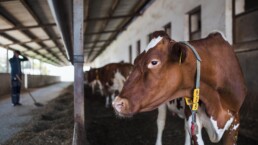Bryanne Hackman
Bryanne Hackman is a Future Africa Forum contributor and expert. Bryanne’s speciality is business strategy and project management.
Share
Sectoral Overview
A strong and efficient agriculture sector is crucial in generating income, promoting food security and creating wealth across the African continent. With 53% of the population of sub-Saharan Africa employed in agriculture, the sector offers the potential to feed its growing population. More urgently, in a COVID-19 era, border closures coupled with trade disruptions, have led policy-makers to re-emphasise that the dependence on global food supply chains is no longer a viable option. African agricultural value chains must be strengthened to improve self-sufficiency.
Despite the potential of the sector, poor access to land, inadequate warehouse storage and out-dated technology are common hindrances in the development of agricultural value chains continent-wide and rather contribute towards low production yields, high post-harvest losses and low revenues. A major constraint underpinning these limitations however, is a lack of access to credit solutions for smallholder farmers.
Access to finance
Despite the agriculture sector generating 15-50% of gross domestic product across various countries, less than 5% of total commercial credit goes to the sector and where access to formal credit solutions do exist, interest rates prove highly unfavourable towards smallholder farmers due to the high-risk nature of the sector because of weather, diseases, pests and commodity price fluctuations. In addition to disadvantaged smallholder farmers, small to medium-sized enterprises (SMEs) in the sector, who today are recognised as agents of investment, are also largely neglected in investment and credit discussions.
In contrast to the scepticism surrounding lending to the agricultural sector, studies show that investments in the sector and access to credit offer promising returns. In Rwanda, for example, for every dollar invested into their agriculture sector, the GDP return is more than three dollars. Providing smallholder farmers and SMEs with access to finance is essential for unlocking long-term sustainable gains, namely food security and increased income within Africa’s agriculture sector. Without this liquidity, the Agricultural sector risks remaining stunted with hopes of achieving self-sufficiency, short-lived.
Warehouse Receipt Financing
Various credit products exist for players along Agricultural value chains, such as venture capital funding for start-ups. However, the new player in the game, Warehouse Receipt Financing is changing the lending landscape for the better.
Warehouse Receipt Systems (WRSs) are already commonly used across the continent. For example, in Ghana, producers and owners of agricultural commodities are able to deliver goods to commercial warehouses and receive a receipt from warehouse operators displaying the quantity, quality and nature of the goods deposited. The goods are then traded according to the details on the receipt.
The difference between WRSs and the Warehouse Receipt Financing (WRF) model however, is that with the latter, the receipt is backed by legislation and regulation and in addition the depositor is able to sell the receipt and therefore the commodities and even use the receipt as collateral to secure bank-backed loans from financial institutions. The money loaned to smallholder farmers can then be used to purchase inputs for the next season.
In Ethiopia, for example, the IFC-backed WRF initiative has expanded access to financing for smallholder farmers, cooperatives and traders and has contributed towards the development of commodity markets since 2009. The system has enabled smallholder farmers to access loans from commercial banks at reasonable rates, thanks to the use of the receipt and therefore their commodity as collateral, thus increasing their ‘credit worthiness’.
WRF offers clear benefits for the Agricultural sector namely, increasing access to finance, reducing lending transaction costs, improving production yields as well as reducing seasonal planning for farmers. The ability to purchase inputs for the next season using these loans is also crucial to encourage higher quality production to reduce post-harvest losses as well as enable commodities to match international standards and therefore lead to more competitive prices for smallholder farmers. WRF can also play a key role in reducing risks associated with lending to smallholder farmers. In all, WRF has the potential to contribute towards higher revenues, reduced post-harvest losses and enhance food security.
In translating lessons from Ethiopia into other country contexts, it is worth highlighting that governments in various countries must create the adequate regulatory and legislative conditions for such a system to exist. Adequate warehousing as well as the accompanying legal framework and documents of title are crucial. Secure transaction laws and regulation of the financial services sector in various countries to ensure favourable deals for smallholder farmers is essential in ensuring the sustainable enhancement of their livelihoods as well as the sector as whole. Ultimately, governments, development partners and financiers must work together to support the development of Agriculture in Africa in and beyond the COVID-19 pandemic.
The views expressed in this article are those of the author alone and not the Future Africa Forum.
The views expressed in this article are those of the author and do not necessarily reflect the views of Future Africa Forum. Future Africa Forum is a pan-African policy think-tank and policy advisory consultancy headquartered in Nairobi, Kenya.


